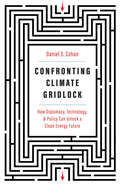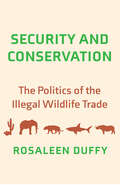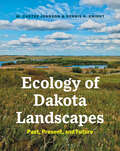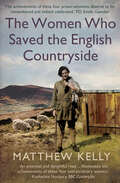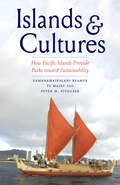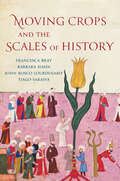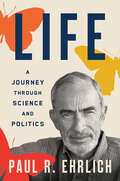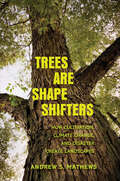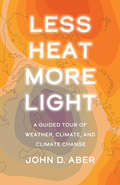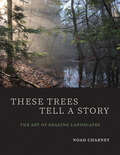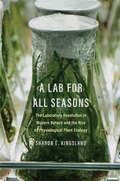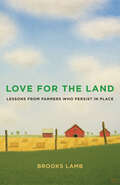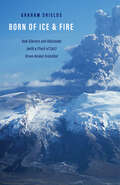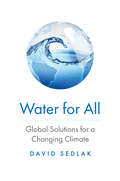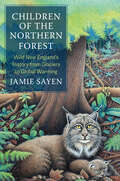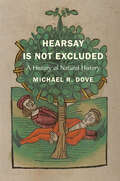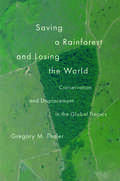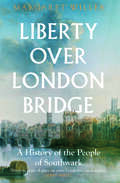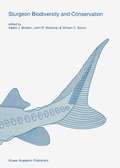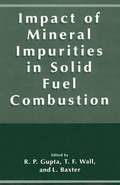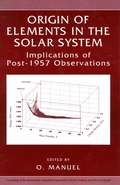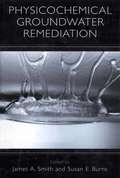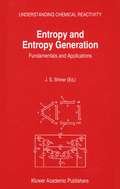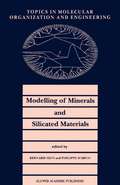- Table View
- List View
Confronting Climate Gridlock: How Diplomacy, Technology, and Policy Can Unlock a Clean Energy Future
by Daniel S CohanAn atmospheric scientist explains why global climate change mitigation and energy decarbonization demand American diplomacy, technology, and policy “Daniel Cohan makes a compelling case that the problem of climate change is solvable. Fixing the gridlock on global action requires fixing the gridlock here in the United States of America. Cohan shows how that can be done.”—David Victor, UC San Diego Professor of environmental engineering Daniel Cohan argues that escaping the gravest perils of climate change will first require American diplomacy, technological innovation, and policy to catalyze decarbonization globally. Combining his own expertise along with insights from more than a hundred interviews with diplomats, scholars, and clean-technology pioneers, Cohan identifies flaws in previous efforts to combat climate change. He highlights opportunities for more successful strategies, including international “climate clubs” and accelerated development of clean energy technologies. Grounded in history and emerging scholarship, this book offers a forward-looking vision of solutions to confronting climate gridlock and a clear-eyed recognition of the challenges to enacting them.
Security and Conservation: The Politics of the Illegal Wildlife Trade
by Rosaleen DuffyAn exploration of the scale, practical reality, and future implications of the growing integration of biodiversity conservation with global security concerns “There are few keener observers of international biodiversity conservation than Rosaleen Duffy. With a ferocity of purpose, she investigates the tenuous connection and nuances among illegal wildlife trade, terrorism threats, and national security.”—Steven R. Brechin, Rutgers University, New Brunswick Debates regarding environmental security risks have generally focused on climate change and geopolitical water conflicts. Biodiversity conservation, however, is increasingly identified as a critical contributor to national and global security. The illegal wildlife trade is often articulated as a driver of biodiversity losses, and as a source of finance for organized crime networks, armed groups, and even terrorist networks. Conservationists, international organizations, and national governments have raised concerns about “convergence” of wildlife trafficking with other serious offenses, including theft, fraud, corruption, drugs and human trafficking, counterfeiting, firearms smuggling, and money laundering. In Security and Conservation, Rosaleen Duffy examines the scale, practical reality, and future implications of the growing integration of biodiversity conservation with global security concerns. Duffy takes a political ecology approach to develop a deeper understanding of how and why wildlife conservation turned toward security‑oriented approaches to tackle the illegal wildlife trade.
Ecology of Dakota Landscapes: Past, Present, and Future
by W. Carter Johnson Dennis H. KnightAn illustrated review of the Northern Great Plains that blends natural history and human history “The most complete, in-depth look at Dakota ecosystems and their history. An absolutely fascinating read!”—Gabe Brown, author of Dirt to Soil W. Carter Johnson and Dennis H. Knight describe the natural and human histories of the Northern Great Plains in this comprehensive and handsomely illustrated book. Covering a vast period of time, they move from geological developments millions of years ago and the effects of glaciers to historical and ecological developments in recent centuries and the effects of agriculture. The book ends with a discussion of the future of this region, mediated by climate change, with recommendations on how to balance agriculture and other pressing needs in the twenty-first century. Johnson and Knight bring decades of experience to chapters on the major ecosystems of the Dakotas. Written for readers with varying backgrounds, and with discussions of the Prairie Pothole Region, the Missouri River, grasslands, woodlands, the Black Hills, and rivers, lakes, and wetlands, the book is unique and will become a long-lasting source of information. Readers will appreciate the plentiful photographs and other color illustrations.
The Women Who Saved the English Countryside
by Matthew KellyA vibrant history of English landscape preservation over the last 150 years, told through the lives of four remarkable women In Britain today, a mosaic of regulations protects the natural environment and guarantees public access to green spaces. But this was not always so. Over the last 150 years, activists have campaigned tirelessly for the right to roam through the countryside and the vital importance of preserving Britain’s natural beauty. Matthew Kelly traces the history of landscape preservation through the lives of four remarkable women: Octavia Hill, Beatrix Potter, Pauline Dower, and Sylvia Sayer. From the commons of London to the Lake District, Northumberland, and Dartmoor, these women protected the English landscape at a crucial period through a mixture of environmental activism, networking, and sheer determination. They grappled with the challenges that urbanization and industrial modernity posed to human well-being as well as the natural environment. By tirelessly seeking to reconcile the needs of particular places to the broader public interest they helped re-imagine the purpose of the English countryside for the democratic age.
Islands and Cultures: How Pacific Islands Provide Paths toward Sustainability
by Kamanamaikalani Beamer Te Maire Tau Peter M. VitousekA uniquely collaborative analysis of human adaptation to the Polynesian islands, told through oral histories, biophysical evidence, and historical records Humans began to settle the area we know as Polynesia between 3,000 and 800 years ago, bringing with them material culture, including plants and animals, and ideas about societal organization, and then adapting to the specific biophysical features of the islands they discovered. The authors of this book analyze the formation of their human-environment systems using oral histories, biophysical evidence, and historical records, arguing that the Polynesian islands can serve as useful models for how human societies in general interact with their environments. The islands’ clearly defined (and relatively isolated) environments, comparatively recent discovery by humans, and innovative and dynamic societies allow for insights not available when studying other cultures. Kamana Beamer, Te Maire Tau, and Peter Vitousek have collaborated with a dozen other scholars, many of them Polynesian, to show how these cultures adapted to novel environments in the past and how we can draw insights for global sustainability today.
Moving Crops and the Scales of History (Yale Agrarian Studies Series)
by Francesca Bray Barbara Hahn John Bosco LourdusamyA bold redefinition of historical inquiry based on the “cropscape”—the people, creatures, technologies, ideas, and places that surround a crop Human efforts to move crops from one place to another have been a key driving force in history. Crops have been on the move for millennia, from wildlands into fields, from wetlands to dry zones, from one imperial colony to another. This book is a bold but approachable attempt to redefine historical inquiry based on the “cropscape”: the assemblage of people, places, creatures, technologies, and other elements that form around a crop. The cropscape is a method of reconnecting the global with the local, the longue durée with microhistory, and people, plants, and places with abstract concepts such as tastes, ideas, skills, politics, and economic forces. Through investigating a range of contrasting cropscapes spanning millennia and the globe, the authors break open traditional historical structures of period, geography, and direction to glean insight into previously invisible actors and forces.
Life: A Journey through Science and Politics
by Paul R. EhrlichA renowned scientist and environmental advocate looks back on a life that has straddled the worlds of science and politics “Entirely entertaining.”—Kirkus Reviews Acclaimed as a public scientist and as a spokesperson on pressing environmental and equity issues, delivering his message from the classroom to 60 Minutes, Paul R. Ehrlich reflects on his life, including his love affair with his wife, Anne, his scientific research, his public advocacy, and his concern for global issues. Interweaving the range of his experiences—as an airplane pilot, a desegregationist, a proud parent—Ehrlich’s insights are priceless on pressing issues such as biodiversity loss, overpopulation, depletion of resources, and deterioration of the environment. A lifelong advocate for women’s reproductive rights, Ehrlich also helped to debunk scientific bias associating skin color and intelligence and warned some fifty years ago about a possible pandemic and the likely ecological consequences of a nuclear war. This book is a vital contribution to literature focused on the human predicament, including problems of governance and democracy in the twenty-first century, and insight into the ecological and evolutionary science of our day. It is a must-read for anyone interested in understanding global change, our planet’s wonders, and a scientific approach to the present existential threats to civilization.
Trees Are Shape Shifters: How Cultivation, Climate Change, and Disaster Create Landscapes (Yale Agrarian Studies Series)
by Andrew S. MathewsAn exploration of the anthropogenic landscapes of Lucca, Italy, and how its people understand social and environmental change through cultivation In Italy and around the Mediterranean, almost every stone, every tree, and every hillside show traces of human activities. Situating climate change within the context of the Anthropocene, Andrew Mathews investigates how people in Lucca, Italy, make sense of social and environmental change by caring for the morphologies of trees and landscapes. He analyzes how people encounter climate change, not by thinking and talking about climate, but by caring for the environments around them. Maintaining landscape stability by caring for the forms of trees, rivers, and hillsides is a way that people link their experiences to the past and to larger scale political questions. The human-transformed landscapes of Italy are a harbinger of the experiences that all of us are likely to face, and addressing these disasters will call upon all of us to think about the human and natural histories of the landscapes we live in.
Wild Visions: Wilderness as Image and Idea
by Ben A Minteer Mark Klett Stephen J. PyneA stunning combination of landscape photography and thematic essays exploring how the concept of wilderness has evolved over time Our ideas of wilderness have evolved dramatically over the past one hundred and fifty years, from a view of wild country as an inviolable “place apart” to one that exists only within the matrix of human activity. This shift in understanding has provoked complicated questions about the importance of the wild in American environmentalism, as well as new aesthetic expectations as we reframe the wilderness as (to some degree) a human creation.Wild Visions is distinctive in its union of landscape photography and environmental thought, a merging of short, thematic essays with a striking visual narrative. Often, the wild is viewed in binary terms: either revered as sacred and ecologically pure or dismissed as spoiled by human activities. This book portrays wilderness instead as an evolving gamut of understandings, a collage of views and ideas that is still in process.
Less Heat, More Light: A Guided Tour of Weather, Climate, and Climate Change
by John D. AberA straightforward and fact-based exploration of how weather happens, how it relates to climate, and how science answers major questions about Earth as a system Climate change is one of the most hotly contested environmental topics of our day. To answer criticisms and synthesize available information, scientists have been driven to devise increasingly complex models of the climate system. This book conveys that the basics of climate and climate change have been known for decades, and that relatively simple descriptions can capture the major features of the climate system and help the general public understand what controls climate and weather, and how both might be changing. Renowned environmental scientist and educator John D. Aber distills what he has learned from a long fascination with weather and climate, the process of science, and the telling of the story of science. This is not a book about policies and politics. Instead, it explores how weather happens, how it relates to climate, and how science has been used to answer major questions about the Earth as a system and inform policies that have reversed environmental degradation. By providing a guided tour of the science of weather, this thoughtful survey will contribute clarity and rationality to the public understanding of climate change.
These Trees Tell a Story: The Art of Reading Landscapes
by Noah CharneyA deeply personal master class on how to read a natural landscape and unravel the clues to its unique ecological history Structured as a series of interactive field walks through ten New England ecosystems, this book challenges readers to see the world through the eyes of a trained naturalist. With guided questions, immersive photography, and a narrative approach, each chapter adds layers of complexity to a single scene, revealing the millions of years of forces at play. Tying together geology, forest ecology, wildlife biology, soil processes, evolution, conservation, and more, Noah Charney shows how and why landscapes appear in their current forms. Charney’s stories and lessons will provide anyone with the necessary investigative skills to look at a landscape, interpret it, and tell its story—from its start as rock or soil to the plants and animals that live on it. Ultimately, Charney argues, by critically engaging with the landscape we will become better at connecting with nature and ourselves.
A Lab for All Seasons: The Laboratory Revolution in Modern Botany and the Rise of Physiological Plant Ecology
by Sharon E. KingslandThe first book to chronicle how innovation in laboratory designs for botanical research energized the emergence of physiological plant ecology as a vibrant subdiscipline Laboratory innovation since the mid-twentieth century has powered advances in the study of plant adaptation, evolution, and ecosystem function. The phytotron, an integrated complex of controlled-environment greenhouse and laboratory spaces, invented by Frits W. Went in the 1950s, set off a worldwide laboratory movement and transformed the plant sciences. Sharon Kingsland explores this revolution through a comparative study of work in the United States, France, Australia, Israel, the USSR, and Hungary. These advances in botanical research energized physiological plant ecology. Case studies explore the development of phytotron spinoffs such as mobile laboratories, rhizotrons, and ecotrons. Scientific problems include the significance of plant emissions of volatile organic compounds, symbiosis between plants and soil fungi, and the discovery of new pathways for photosynthesis as an adaptation to hot, dry climates. The advancement of knowledge through synthesis is a running theme: linking disciplines, combining laboratory and field research, and moving across ecological scales from leaf to ecosystem. The book also charts the history of modern scientific responses to the emerging crisis of food insecurity in the era of global warming.
Love for the Land: Lessons from Farmers Who Persist in Place (Yale Agrarian Studies Series)
by Brooks LambA moving exploration of presence and place told through the stories of small-scale farmers who, despite intense adversity, continue caring for their land Love for the Land explores the power and potential of people-place relationships. Through clear and compelling prose, it elevates the virtues of imagination, affection, and fidelity—concepts promoted by farmer-writer Wendell Berry—and shows how they motivate small- and mid-scale farmers to care for the land, even in the face of adversity. Paying particular attention to farmland loss from suburban sprawl, rampant agricultural consolidation, and, for farmers of color, racial injustice, Brooks Lamb reckons with the harsh realities that these farmers face. Drawing from in-depth interviews and hands-on experiences in two changing rural communities, he shares stories and sacrifices from dozens of farmers, local leaders, agricultural service providers, and land conservationists. Lamb’s rural roots and farming background enable him to cultivate honest, trusting connections with the farmers he engages, yielding raw and powerful insights. Time and again, compelling evidence reveals that stewardship virtues encourage people to live and act as devoted caretakers. With a refreshing, accessible, and engaging approach, Lamb argues that these resilient and often overlooked farmers show rural and urban people alike a way forward, one that serves people, places, and the planet. That path is rooted in love for the land.
Born of Ice and Fire: How Glaciers and Volcanoes (with a Pinch of Salt) Drove Animal Evolution
by Graham ShieldsAn exploration of how the Cryogenian Period, when our planet was covered in ice for millions of years, created today’s remarkable biodiversity More than half a billion years ago, our world was completely covered by glaciers, a “Snowball Earth” that persisted for millions of years. Incredibly, this unimaginable cold led to the remarkable diversification of life on earth known as the Cambrian explosion. With a geologist’s eye and a knack for storytelling, Graham Shields explores when and how such inhospitable conditions enabled animals to evolve, radiate, and diversify into our earliest ancestors. This journey navigates the wild swings between hot and cold climates, oxygenation and asphyxiation, biological radiations and extinctions, asking how such instability relates to grander forces that brought our planet to its modern state. Shields guides readers through evidence found in the Australian outback, Mongolia, Scotland, and other locales, revealing how geologists can trace glaciation, the atmosphere, oceans, mountain building, and more through the earth’s rocks, providing a comprehensive theory of how life evolved and diversified.
Water for All: Global Solutions for a Changing Climate
by David SedlakA fresh look at the world’s water crises, and the existing and emerging solutions that can be used to solve them It is not your imagination: water crises are more frequent. Our twentieth-century systems for providing the water that grows food, sustains cities, and supports healthy ecosystems are failing to meet the demands of growing population and the challenges brought on by climate change. But the grim news reports—of empty reservoirs, withering crops, failing ecosystems—need not be cause for despair, argues award-winning author David Sedlak. Communities on the front lines of previous water crises have pioneered approaches that are ready to be applied elsewhere. Some have resolved shortages by enhancing water-use efficiency, and others have used moments of crisis to resolve historic disagreements over water rights. Still others have employed treatment technologies that unlock vast quantities of untapped water resources. Sedlak identifies the challenges that society faces, including ineffective policies and outdated infrastructure, and the myriad of tools at our disposal—from emerging technologies in desalination to innovations for recycling wastewater and capturing more of the water that falls on fields and cities. He offers an informed and hopeful approach for rethinking our assumptions about the way that water is managed. With this knowledge we can create a future with clean, abundant, and affordable water for all.
Children of the Northern Forest: Wild New England's History from Glaciers to Global Warming (Yale Agrarian Studies Series)
by Jamie SayenThis no-holds-barred narrative of the failure of conservation in northern New England’s forests envisions a wilder, more equitable, lower-carbon future for forest-dependent communities Jamie Sayen approaches the story of northern New England’s undeveloped forests from the viewpoints of the previously unheard: the forest and the nonhuman species it sustains, the First Peoples, and, in more recent times, the disenfranchised human voices of the forest, including those of loggers, mill workers, and citizens who, like Henry David Thoreau, wish to speak a kind word for nature. From 1988 to 2016 paper companies sold their timberlands and closed seventeen paper mills in northern New England. Policy makers ceded veto power to large absentee landowners, who tried to preserve the status quo by demanding additional tax cuts and other subsidies for economic elites. They vetoed measures designed to restore and preserve forest health; at present, about half of the former industrial forests are classified as degraded, and the regional economy continues to be trapped in low-value commodity markets. This book operates as a case study of how a rural resource region can respond to a global economy responsible for climate change, habitat loss and degradation, and environmental injustice. Sayen offers a blueprint for restoring vast wildlands and transitioning to a lower-carbon, high-value-adding, local economy, while protecting the natural rights of humans, nonhumans, and unborn generations.
Hearsay Is Not Excluded: A History of Natural History (Yale Agrarian Studies Series)
by Michael R. DoveThis chronicle of natural history argues that the modern environmental crisis and rise in science skepticism codeveloped with the rise of ever narrower scientific disciplines For millennia, the field of natural history promoted a knowledgeable and unifying view of the world. In contrast, the modern rise of narrow scientific disciplines has promoted a dichotomy between nature and culture on the one hand and between scientific and folk knowledge on the other. Drawing on the fields of anthropology, history, and environmental science, Michael R. Dove argues that the loss of this historic holistic vision of the world is partly to blame for contemporary environmental degradation and science skepticism. Dove bases this thesis on a study of four pioneering natural historians across four centuries: Georg Eberhard Rumphius (seventeenth century), Carl Linnaeus (eighteenth century), Alfred Russel Wallace (nineteenth century), and Harold C. Conklin (twentieth century). Dove studies their field craft and writing; the political, cultural, and environmental circumstances in which they worked; the sources of their insight; and the implications of their work for modern society. Most of all, the book seeks to discover what enabled those natural historians to straddle boundaries that today seem impassable and to distill that wisdom for a modern world greatly in need of a holistic vision of people and environment.
Saving a Rainforest and Losing the World: Conservation and Displacement in the Global Tropics (Yale Agrarian Studies Series)
by Gregory M. ThalerAn unflinching investigation of the false promises of land sparing, exposing how its illusory successes mask the failures of green capitalism For two decades, the concept of land sparing, the claim that agricultural intensification can spare land by preventing forest clearing for agricultural expansion, has dominated tropical forest conservation. Land sparing policies transform landscapes and livelihoods with the promise of reconciling agricultural development with environmental conservation. But that land sparing promise is false. Based on six years of research on agrarian frontiers in Indonesia, Brazil, and Bolivia, this book traces where and how land sparing becomes policy and charts the social and ecological effects of these political contests. Gregory M. Thaler explains why land sparing appears successful in some places but not in others and reveals that success as an illusion achieved by displacing deforestation to new frontiers. The failure of land sparing exposes a harsh truth behind assurances of green capitalism: capitalist development is ecocide.
Liberty over London Bridge: A History of the People of Southwark
by Margaret WillesThe first complete history of Southwark, London’s stubbornly independent community over the Thames Southwark’s fortunes have always been tied to those of the City of London across the river. But from its founding in Roman times through to flourishing in the medieval era, the Borough has always fiercely asserted its independence. A place of licence, largely free of the City’s jurisdiction, Southwark became a constant thorn in London’s side: an administrative anachronism, a commercial rival, and an asylum for undesirable industries and residents. In this remarkable history of London’s liberty beyond the bridge, Margaret Willes narrates the life and times of the people of Southwark, capturing the Borough’s anarchic spirit of revelry. Populated by a potent mix of talented immigrants, religious dissenters, theatrical folk, brewers, and sex workers, Southwark often escaped urban jurisdiction—giving it an atmosphere of danger, misrule, and artistic freedom. Tracing Southwark’s history from its Roman foundation to its present popularity as a place to visit, through Chaucer, to Shakespeare, and on to Dickens, Willes offers an indispensable exploration of the City’s unacknowledged mirror image.
Sturgeon biodiversity and conservation (Developments in Environmental Biology of Fishes #17)
by Vadim J. Birstein John R. Waldman William E. BemisSelected, reviewed and revised papers from the International Conference on Sturgeon Biodiversity and Conservation held at The American Museum of Natural History in New York on 28-30 July 1994
Impact of Mineral Impurities in Solid Fuel Combustion
by R. Gupta T. Wall L. BaxterThis book contains papers presented at the Engineering Foundation Conference on mineral matter in fuels held on November 2-7, 1997 in Kona, Hawaii. The conference is one of a continuing series that was initiated by the CEGB Mar- wood Engineering Laboratories in 1963. The conference was to be eventually organised by the Engineering Foundation as the need for multi-disciplinary work related to c- trolling ash effects in combustors became apparent. The conference covers both the science and the applications. The papers also present case histories, particularly for current fuel technologies, developments in advanced technologies for power generation and mathematical modelling of these processes. Developments since 1963 have been slow, but steady, due to the complexity of the chemical and physical processes involved. However, the research presented here displays great improvement in our understanding of the mechanisms by which mineral matter will influence fuel use. Steve Benson from EERC presented a review and current status of issues related to ash deposition in coal combustion and gasification. The application of new analytical tools, which have been detailed in the previous conferences, is presented. These include CCSEM, as well as new techniques for char- terising sintering of ash, such as TMA, image analysis, X-ray diffraction crystallography and thermal analysis. The new analytical techniques were extended to encompass widely differing fuels such as biomass. Ole H Larsen from ELSAM Denmark presented a review of these advanced techniques.
Origin of Elements in the Solar System: Implications of Post-1957 Observations
by Oliver K. ManuelBased on an American Chemical Society Symposium organized by Professors Glenn Seaborg and Oliver Manuel, this volume provides a comprehensive record of different views on this important subject at the end of the 20th century. They have assembled a blend of highly respected experimentalists and theorists from astronomy, geology, meteoritics, planetology and nuclear chemistry and physics to discuss the origin of elements in the solar system. The intent was to include all points of view and let history judge their validity.
Physicochemical Groundwater Remediation (Aids Prevention And Mental Health Ser.)
by James A. SmithAs we transition into the 21st century, it is apparent that this is an exciting time for environmental engineers and scientists studying remediation technologies. There has been a rapid development of new ways to clean-up polluted groundwater. Research activities of the past and next 10 years will have a dramatic impact on the quality of the subsurface environment for the next century. In 20, or even 10 years from now, our approach to subsurface remediation will probably be vastly different than it is today. Many of the emerging technologies presented in this book will form the basis of standard remediation practices of the future. Physicochemical Groundwater Remediation presents detailed information on multiple emerging technologies for the remediation of the contaminated subsurface environment. All of these technologies apply our knowledge of physical and chemical processes to clean up ground water and the unsaturated zone, and many (if not all) of these emerging technologies will help define standard practices in the future. These technologies include in situ sorptive and reactive treatment walls, surfactant-enhanced aquifer remediation, optimization analyses for remediation system design, chemical, electrochemical, and biochemical remediation processes, and monitored natural attenuation. You will learn how palladium catalyzes the dehalogenation of chlorinated solvents. You will find out how barometric pumping can naturally remove significant quantities of volatile organic pollutants from shallow ground water and the unsaturated zone. You can learn about mobilizing non-aqueous phase liquids (NAPLs) without risking significant downward migration of the NAPL. You can find out how processes such as electroosmosis and electromigration can be exploited for groundwater remediation purposes and how zero-valent iron and zeolite treatment walls can be used in situ to treat and control contaminant plume migration. Contributors to this book are experts in groundwater remediation processes, and they represent industry, consulting, academia, and government. If your work involves the clean up of contaminated soil and groundwater, this book is an essential reference to keep you up to date on the most promising new developments in remediation research.
Entropy and Entropy Generation: Fundamentals and Applications (Understanding Chemical Reactivity #18)
by J. S. ShinerEntropy and entropy generation play essential roles in our understanding of many diverse phenomena ranging from cosmology to biology. Their importance is manifest in areas of immediate practical interest such as the provision of global energy as well as in others of a more fundamental flavour such as the source of order and complexity in nature. They also form the basis of most modern formulations of both equilibrium and nonequilibrium thermodynamics. Today much progress is being made in our understanding of entropy and entropy generation in both fundamental aspects and application to concrete problems. The purpose of this volume is to present some of these recent and important results in a manner that not only appeals to the entropy specialist but also makes them accessible to the nonspecialist looking for an overview of the field. This book contains fourteen contributions by leading scientists in their fields. The content covers such topics as quantum thermodynamics, nonlinear processes, gravitational and irreversible thermodynamics, the thermodynamics of Taylor dispersion, higher order transport, the mesoscopic theory of liquid crystals, simulated annealing, information and biological aspects, global energy, photovoltaics, heat and mass transport and nonlinear electrochemical systems. Audience: This work will be of value to physicists, chemists, biologists and engineers interested in the theory and applications of entropy and its generation.
Modelling of Minerals and Silicated Materials (Topics in Molecular Organization and Engineering #15)
by B. Silvi P. D'ArcoThe modeling of minerals and silicated materials is a. difficult challenge faced by Solid StatePhysics, Quantum Chemistry and Molecular Dynamics communities. The difficulty of such a modeling is due to the wide diversity of elements, including heavy atoms,and types of bonding involved in such systems. Moreover, one has to consider infinite systems: either perfect cr- tals or glasses and melts. In the solid state a given chemical composition gives rise to numerous polymorphs, geometricallycloselyrelated. These polymorphs have very similar energies and related thermodynamical pr- erties which explain the complexity of their phase diagrams. The modeling of silicates and minerals covers a wide field of applications ranging from basic research to technology, from Solid State Physics to Earth and Planetary science. The use of modeling techniques yields information of different nature. In the case of chemical studies, we can mention inv- tigations on catalytic processes occurring on surfaces and in zeolite cages. These calculations find possible applications in chemical engineering, in particular in the oil industry.
